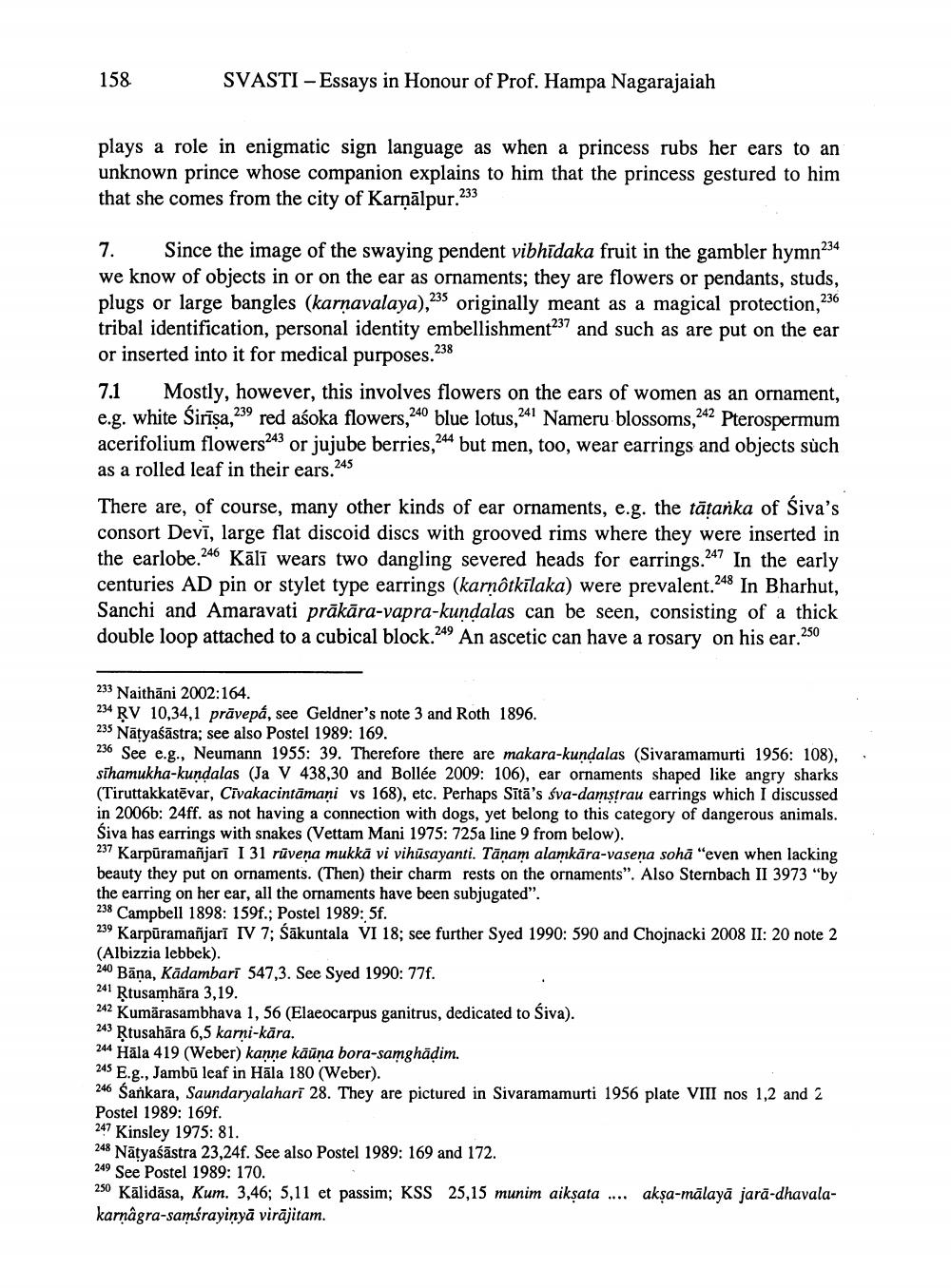________________
158
SVASTI-Essays in Honour of Prof. Hampa Nagarajaiah
plays a role in enigmatic sign language as when a princess rubs her ears to an unknown prince whose companion explains to him that the princess gestured to him that she comes from the city of Karṇālpur."
7.
235
Since the image of the swaying pendent vibhīdaka fruit in the gambler hymn234 we know of objects in or on the ear as ornaments; they are flowers or pendants, studs, plugs or large bangles (karṇavalaya), originally meant as a magical protection,256 tribal identification, personal identity embellishment237 and such as are put on the ear or inserted into it for medical purposes.238
7.1
Śirīṣa,
242
Mostly, however, this involves flowers on the ears of women as an ornament, e.g. white Sirisa,29 red aśoka flowers,240 blue lotus,241 Nameru blossoms, Pterospermum acerifolium flowers or jujube berries,244 but men, too, wear earrings and objects such as a rolled leaf in their ears.245
243
246
There are, of course, many other kinds of ear ornaments, e.g. the tatanka of Śiva's consort Devi, large flat discoid discs with grooved rims where they were inserted in the earlobe. Kali wears two dangling severed heads for earrings. In the early 247 248 centuries AD pin or stylet type earrings (karnôtkilaka) were prevalent. In Bharhut, Sanchi and Amaravati präkāra-vapra-kundalas can be seen, consisting of a thick double loop attached to a cubical block.249 An ascetic can have a rosary on his ear.25
250
233 Naithani 2002:164.
234 RV 10,34,1 prāvepá, see Geldner's note 3 and Roth 1896. 235 Natyaśāstra; see also Postel 1989: 169.
236 See e.g., Neumann 1955: 39. Therefore there are makara-kuṇḍalas (Sivaramamurti 1956: 108), sihamukha-kundalas (Ja V 438,30 and Bollée 2009: 106), ear ornaments shaped like angry sharks (Tiruttakkatēvar, Cīvakacintamani vs 168), etc. Perhaps Sītā's sva-damṣṭrau earrings which I discussed in 2006b: 24ff. as not having a connection with dogs, yet belong to this category of dangerous animals. Śiva has earrings with snakes (Vettam Mani 1975: 725a line 9 from below).
237 Karpūramañjarī I 31 rūveņa mukkā vi vihūsayanti. Tāṇam alamkāra-vaseṇa sohā "even when lacking beauty they put on ornaments. (Then) their charm rests on the ornaments". Also Sternbach II 3973 "by the earring on her ear, all the ornaments have been subjugated".
238 Campbell 1898: 159f.; Postel 1989: 5f.
239 Karpūramañjarī IV 7; Śākuntala VI 18; see further Syed 1990: 590 and Chojnacki 2008 II: 20 note 2 (Albizzia lebbek).
240 Bāṇa, Kādambari 547,3. See Syed 1990: 77f.
241
Ṛtusamhāra 3,19.
242
Kumarasambhava 1,56 (Elaeocarpus ganitrus, dedicated to Śiva).
243 Ṛtusahāra 6,5 karni-kāra.
2441 Hāla 419 (Weber) kaṇne kāūņa bora-samghāḍim.
245 E.g., Jambu leaf in Hala 180 (Weber).
246 Sankara, Saundaryalahari 28. They are pictured in Sivaramamurti 1956 plate VIII nos 1,2 and 2
Postel 1989: 169f.
247 Kinsley 1975: 81.
248 Natyaśāstra 23,24f. See also Postel 1989: 169 and 172.
249 See Postel 1989: 170.
150 Kalidasa, Kum. 3,46; 5,11 et passim; KSS 25,15 munim aikṣata karṇagra-samfrayinyā virājitam.
akṣa-mālayā jarā-dhavala




